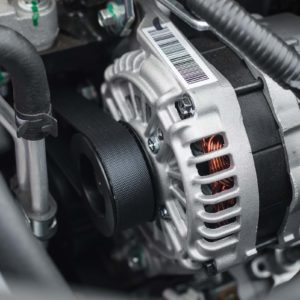The alternator charges the battery, which in turn provides electrical power for various parts and systems in the vehicle. Powered by the engine, the alternator ensures that the battery is fully charged. On modern vehicles, it is often controlled by the engine control module (ECM) or powertrain control module (PCM).
The PCM checks the state of the alternator’s field circuit. If it detects a lower-than-normal voltage signal from the device’s generator field coil circuit, its diagnostics will log a P0625 code.
What Does the P0625 Code Mean?
The diagnostic trouble code (DTC) P0625 indicates “Generator Field/F Terminal Circuit Low.” F terminal refers to the field coil control circuit.
One of the most important parts of the alternator is its generator field coil. Located inside the alternator housing, the field coil winds around the armature that carries alternating current. It’s usually possible to see the windings of the coil by peering through the vent holes cut into the housing.

When the engine starts up, the field coil draws voltage from the battery to energize itself. The energized coil stays still while the armature rotates within it.
As long as the engine is running, the PCM regularly checks the generator field coil. It measures the field circuit’s continuity and voltage level. If the signal voltage from the field coil circuit is lower than the expected values stored in the module’s memory, the PCM will set the generic code P0625.
Note: The definition of code P0625 can differ according to the vehicle manufacturer. Check the appropriate repair manual or repair database for the exact code definition.
What are the Common Causes of the P0625 Code?
- Bad alternator
- Faulty battery
- Bad PCM
- Wiring issues
- Broken alternator drive belt

What are the Common Symptoms of the P0625 Code?
- Illuminated check engine light
- Charging system warning light turns on
- Engine doesn’t start due to a dead battery
- Engine stalls while running
How to Diagnose the P0625 Code
The P0625 code is a generic trouble code that can be logged in different makes and models. Depending on various factors, the specific steps of identifying the root cause of the trouble code and fixing the issue can change between cases.
If you lack the confidence to run a diagnostic test on your vehicle, it is recommended to bring it to a professional mechanic. Otherwise, you can go ahead and diagnose the issue yourself. To help you get started, here is a video that can give you an idea of what the process might involve:
How to Fix the P0625 Code
Attempting to fix a P0625 code can become a challenging task if you don’t have the right tools and know-how to test the alternator. In most cases, it’s best to leave the job to professionals.
DIYers with sufficient technical knowledge and hands-on experience can diagnose and replace their vehicle’s alternator on their own. It’s a good idea to refer to the appropriate repair manual or refer to an online repair database.
Any information provided on this Website is for informational purposes only and is not intended to replace consultation with a professional mechanic. The accuracy and timeliness of the information may change from the time of publication.

















